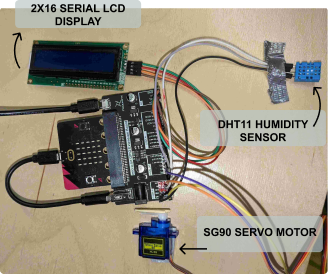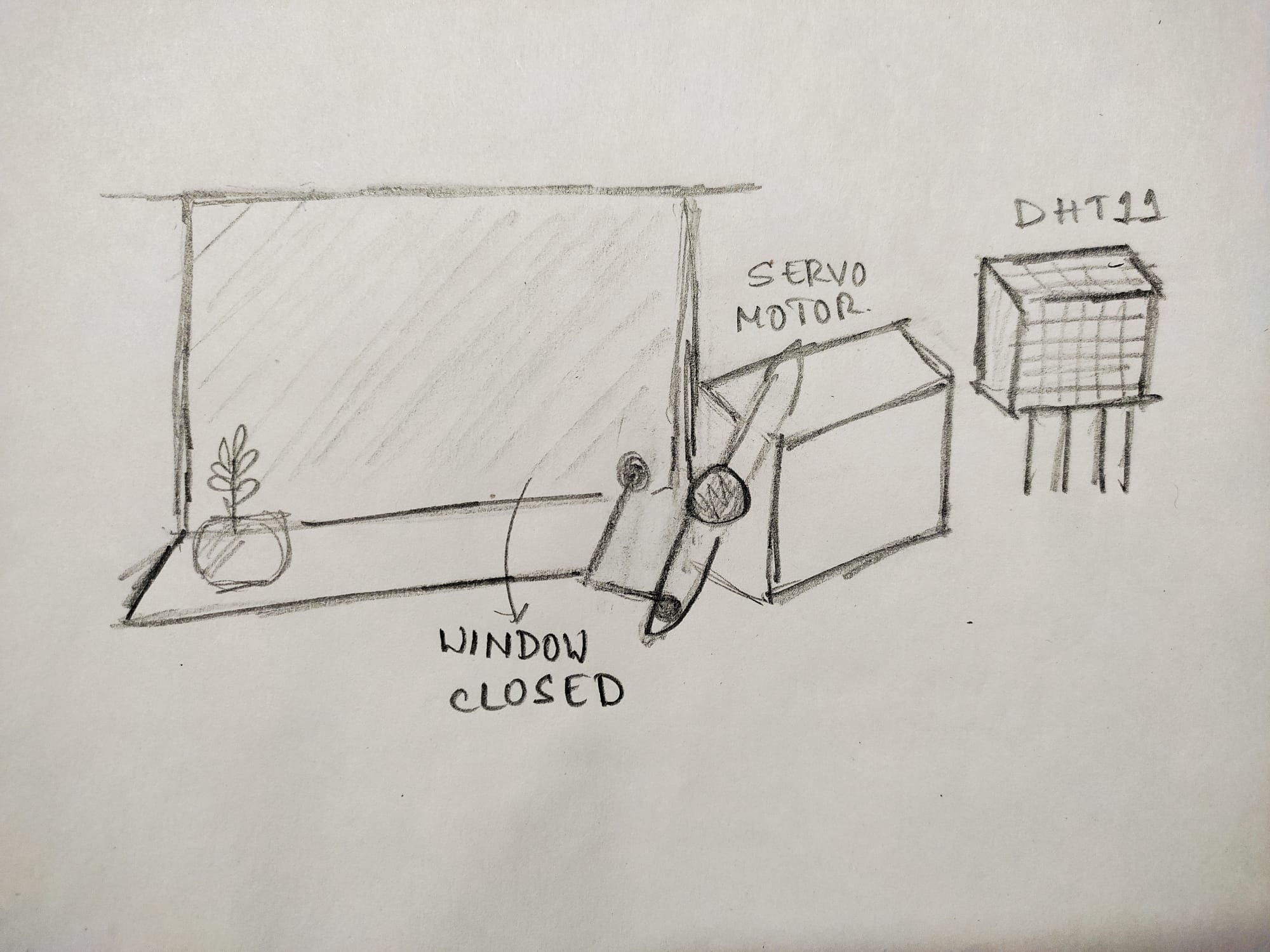
Humidity levels inside a home can significantly impact the health and comfort of its occupants and also can substantially impact sustainability in terms of energy efficiency and environmental impact. In the UK alone over the past year, 4.7 million private renters in Britain have had to deal with fungus in their homes, exacerbating the country's "mould epidemic".
The task was to design a solution addressing the significant impact of humidity levels on home environments' health, comfort, and sustainability. The cost-of-living crisis has exacerbated this problem, forcing landlords and tenants to reduce heating usage. People often leave windows open to minimise fog inside the home to save on energy bills. However, forgetting to close the window or having to leave for work immediately can lead to heat loss. The challenge was to design a solution that helps manage these issues effectively.

Image Source : https://waterleak.co.uk/report/black-mould/
Humidity levels that are too high or too low can lead to structural damage in homes and potential health issues. For a comfortable indoor environment, it's ideal to maintain humidity levels between 30% and 60%.It's suggested that the best range for human health and well-being is between 45% and 55%. When humidity levels are high, air conditioning systems need to work harder to remove moisture from the air, leading to increased energy usage and costs.

The Automated-Ventilation is a concept design responding to the design brief, which helps promote environmentally friendly sustainability behaviour.
Rationale
The project's colour scheme revolves around the Wandercard, the main physical prototype. We chose red as the primary colour to grab attention and promote responsiveness. Consistency in the colour scheme was maintained throughout the design, including the Kiosk's UI and WanderCard.
State-of-the-art Review
At present, ventilation systems are designed to regulate humidity, focusing on sealing gaps and pre-warming the air in homes. There are also remote-controlled systems that maintain temperature for plant preservation in greenhouses. However, there's no major development yet in automating home ventilation.
Concept Development
The project began with exploring ideas related to sustainable housing, prompted by recent news about the rising cost of living, increased death rates from colds, and respiratory issues in children due to prolonged mould exposure. Modern buildings often use fog extractors and dehumidifiers to maintain optimal humidity levels. Still, these are only affordable for some households and consume significant energy.
Interestingly, older buildings, such as Victorian structures, have weathered similar conditions and remain in excellent condition. These buildings were managed more naturally, with porous materials and breathable paints like limewash acting as absorbents that dried from wind and sunlight. This study led to the use of natural sources as much as possible to address humidity issues.

Initial Sketch - Humidity sensor placement and a motor to move the window.

Initial Sketch - Display of humidity level (using DHT11 sensor)
It was decided to start with a humidity sensor to determine the house's humidity level. Research indicated that each home and its rooms have unique humidity levels. The average humidity inside UK homes should be around 50-55% RH (relative humidity), slightly lower in winter. The plan was to use a humidity sensor to determine a room's humidity level, then use a motor to open a window if the level was higher than usual (indicating potential condensation), and close the window once the desired humidity level was reached. Initial sketches were made to understand the coordination between the humidity sensor and the motor.
The original idea was to calculate the humidity level and display it on a screen or alert the user. However, this would only be helpful if the user knew exactly what to do with the generated data. Therefore, a motor would open and close windows automatically without human intervention based on the data collected by the humidity sensor in different areas of the house (like the kitchen and bathroom, where humidity is typically higher).
Programming the BBC Micro:bit

Initial assembly of all the components
The project utilised a BBC micro:bit, programmed using online tutorials for the DHT11 sensor, a popular and affordable microcontroller sensor, and the SG90 micro servo motor, which can rotate up to 180 degrees when given maximum torque. A 2x16 serial LCD screen was also used to display humidity readings.
The programming of the micro bit involved two stages. The first was programming the micro bit to read the room’s humidity. The second was adjusting the angle of the servo meter arm based on the DHT11 reading. During testing, it was found that the DHT11 sensor was not reading the humidity correctly, displaying negative values upon power supply and taking longer than expected. A delay was added to address this before reading, as the DHT11 sensor can take up to 2 seconds to read new data between intervals.
Prototypes were created based on initial sketches. Due to the prototype’s small size, creating a hinge to connect the window and the servo arm was challenging. Therefore, the servo was positioned so that its arm could perform the window opening/closing action directly.
Physical Prototyping

When humidity is set to an particular value, servo motor is set to 0°, and window will be closed

When humidity exceeds threshold value, servo motor is set to 180°, and window will be open
I created a structure resembling a room with a window using thin cardboard. As per requirement, I made a window with movable hinges, as shown in below figure.

Window with moving hinges, fixed with servo motor

When humidity is set to an particular value, servo motor is set to 0°, and window will be closed

When humidity exceeds threshold value, servo motor is set to 180°, and window will be open
A tube was used to exhale hot air for testing purposes, creating a humid atmosphere around the DHT11 sensor. When the micro bit was powered, the humidity sensor read the initial data and continued to read data every two seconds with little or no variation in value.
The value increased rapidly when the top of the structure was closed, and hot air was exhaled near the DHT11. Humidity triggered the servo motor to change the angle of its arm, opening the window. The servo motor arm closed the window as the humidity returned to its previous value.The value increased rapidly when the top of the structure was closed, and hot air was exhaled near the DHT11. Humidity triggered the servo motor to change the angle of its arm, opening the window. The servo motor arm closed the window as the humidity returned to its previous value. The test demonstrated that it’s possible to balance humidity in a house by creating ventilation, thereby reducing associated risks.


This basic prototype shows users can maintain data on the humidity nature of a particular room daily and weekly and can be automated to set the humidity. Using natural renewable resources as much as possible rationally can reach the goal of sustainability.

Final Prototype


Reflection
This project's journey leaned more towards manifestation, as it involved bringing ideas from imagination to life in the form of an actual prototype. This process helped in understanding the possibilities and exploring new ways to create this prototype despite the widespread concept of ventilation.
However, a few challenges need to be addressed in future work. Firstly, the servo motor used in the prototype can't lift isn't an actual window. A real-world product would require a stronger motor, which would consume electricity. Additionally, the DHT11 sensor had issues reading humidity when switched on, taking a while to read and update.
Secondly, this idea has security concerns, as leaving a window open unattended can be unsafe. Lastly, the window can only be left open in good weather. In these scenarios, the design could be updated to prompt user intervention.
In conclusion, despite these challenges, this project represents a significant step towards sustainable and natural ventilation solutions. It underscores the importance of continuous innovation and improvement in pursuing sustainable living solutions.
Images from development phase





Project Overview
- Category: Physical Prototyping
- Project Name: Sustainable Data in the Home - Annotated Portfolio
- Domain: Prototyping
- Team Members: Madhura Nanjundaiah
Design Brief:
The design brief was to design a concept for a new data-driven technology for the home. This technology was required to capture, log, and use data about home activities to promote more environmentally sustainable behaviour. Part of the brief was to create a 3D prototype of the concept, using any available materials to convey the idea effectively. The use of a micro:bit in the prototype was optional.
